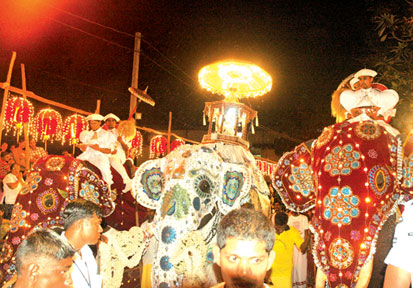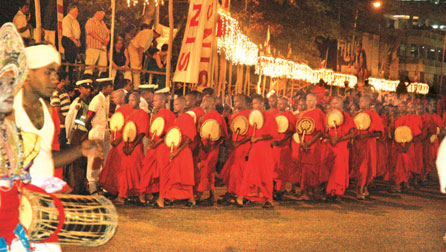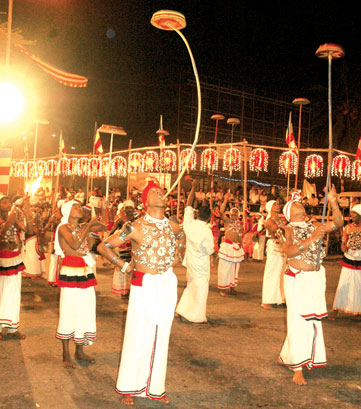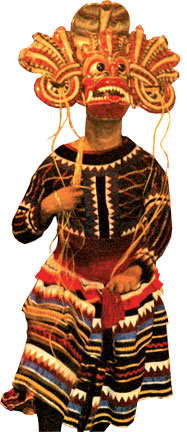|
Navam Perahera:
Colombo’s dazzling cultural spectacle
By Nilma DOLE
A whirlwind of colours, breathtaking dances, rhythmic beats and
dazzling lights together with majestic elephants culminated in a
spectacular experience of culture and religious tradition at the Navam
Perahera held in all its splendour last week.
 The Navam Perahera, which is held every February, is a vibrant
pageant which marks the glory of the important day of Navam Poya.
Thousands of spectators throng the area to witness one of Sri Lanka’s
most wonderful pageants, second only to the Kandy Esala Perahera. The Navam Perahera, which is held every February, is a vibrant
pageant which marks the glory of the important day of Navam Poya.
Thousands of spectators throng the area to witness one of Sri Lanka’s
most wonderful pageants, second only to the Kandy Esala Perahera.
This year saw President Mahinda Rajapaksa marking the opening of the
Navam Perahera with his son, Sub-Lieutenant Yoshitha Rajapaksa. They
carefully placed the Gangarama Temple’s sacred relic casket on the main
tusker, Ranaraja.
The President, in his speech, said that the Navam Perahera is a
milestone event that unites Sri Lankans all over the country and is an
event that is enjoyed and witnessed by all.
“After we brought peace to
Sri Lanka, we can enjoy and celebrate unity, peace and harmony where
people from all walks of life, different ethnicities and various
religions can be a part of the Navam Perahera which is Colombo’s
dazzling cultural spectacle,” he said.
While the recent devastating floods caused havoc in our country,
donations have poured in to help the affected. The Chief Incumbent of
the Gangarama Temple Ven. Galaboda Gnanissara Thera (Podi Hamuduruwo)
who is also responsible for organising the Perahera annually, said that
a considerable part of the donations has already been allocated as flood
relief assistance with donations from the Navam Perahera also
contributing to this cause.
 So, this year, it was enjoyment and charity
going hand-in-hand to make the Navam Perahera a worthy and discerning
experience. So, this year, it was enjoyment and charity
going hand-in-hand to make the Navam Perahera a worthy and discerning
experience.
It is a long procession where many elephants and over a 1,000
performers took to the streets to showcase their talents.
Launched in 1979, the Navam Perahera attracts more than a million
spectators with free seating on the pavements and special box seats too
being available on a first-come first-served basis.
Blowing of conch-shells
The Navam Perahera starts with the blowing of conch-shells by
performers, engulfing the spectators in a magical incantation. The
nearly mile-long parade takes off on a pleasant note with young boys
cracking whips, and collecting coins from the audience as a donation
towards making the Perahera a success.
The thrilling drum beats and flutes combine into a magical plethora
of percussion. The different drumming performances provide an air of
vibrancy, setting an energetic atmosphere with colourful traditional
costumes.
The agile dancers perform with skill as they show the different
dances pertaining to every part of the country. This prestigious
Buddhist pageant also boasts other types of entertainers such as stilt
walkers who are decked in long pants. Some as young as six years often
parade on stilts.
Silently treading barefoot are bhikkhus clad in saffron robes; they
solemnly walk in the procession.
  The pageant of elephants, dressed in their customary outfits add
glamour to the parade, making it a fashion extravaganza with
rainbow-coloured costumes revealing the hard work that had gone into
making them look magnificent. The pageant of elephants, dressed in their customary outfits add
glamour to the parade, making it a fashion extravaganza with
rainbow-coloured costumes revealing the hard work that had gone into
making them look magnificent.
Dressed in white and carrying Buddhist flags are young participants
gathered neatly in a queue, after the elephant bearing the sacred relic.
With the tranquil Beira Lake as the backdrop, the main tusker, a
majestic and magnificent elephant with lovely and spectacular tusks,
walks in all its glory, brilliantly decorated for the world to witness.
This year the tusker wore a peacock-blue, delicately designed costume
which glimmered in gold and silver.
The century-old small temple in the Beira Lake, which is called the
Seema Malaka, is also part of the stunning background where the Navam
Perahera takes place. The event was beamed live on the Buddhist
satellite TV channel.Held on two consecutive nights, February 16 and 17,
the performers in the Navam Perahera have put their hands together to
make this grand pageant a success.
|

